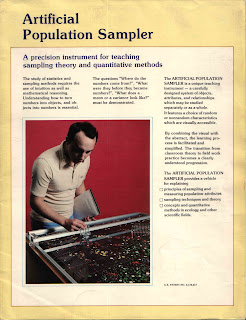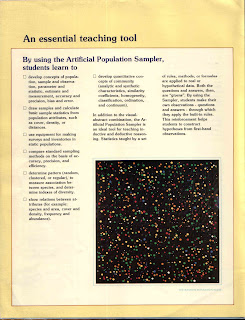






I found this brochure in an old file. It dates from 1978. It shows a physical model for teaching sampling and quantitative methods in ecology. Click on the images for larger views. Developed by Arnold M. Schultz, a Professor of Systems Ecology at the University of California, Berkeley and used as a teaching tool beginning in 1958. His 1961 patent application seen
here was awarded in 1965.
The model contains two plates of plastic containing arrangements of vinyl discs of various sizes and colors that represent populations in a square region of the Cartesian plane. One plate is called the random population plate made up of six colors that seem to be distributed uniformly over the square. The other plate is called the nonrandom population plate made up of 19 colors that are arranged in rough clusters to illustrate more contiguous, local populations. Instruments are provided for measuring locations and size. Along with color they provide both qualitative and quantitative data for estimating means, variances, density, diversity from various random sampling methods. The population parameters are fixed in each of the plates allowing assessment of measurement error and bias.
A paper by Schultz et al. from the Journal of Range Management (1961,v14,n5,pp 236-242) illustrates its use. I've found one
listing of the color distribution (from the paper "A comparison of techniques for assessing dispersion patterns," D.W. Goodall and N.E. West, Vegetatio, (40)1:15-27, 1979) but other than a reference to it having six sizes, nothing explicit about the size distribution.
A real hands-on approach to sampling that is very useful for both teaching and research. An example in teaching is illustrated
here. Its use in ecological research in 2006 is shown
here.












